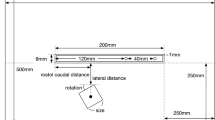Summary
-
1.
Metal and plastic objects moved near to the animal's (Apteronotus albifrons) body (5 mm lateral) evoke changes in receptor activity consisting primarily of increases in the case of metal and decreases due to plastic. No receptors showed similar responses to both types of objects (Fig. 1).
-
2.
Objects moved parallel to the long axis of the fish at sequentially greater distances evoked responses which decayed as a power function of distance. The exponents describing this response fall-off ranged from −1.1 to −2.5 and are in good agreement with calculated changes in trans-epidermal voltage due to the presence of objects at increasing distances from the fish.
-
3.
Increasing or decreasing object size did not markedly alter the rate of response decay but shifted the response-distance relationship so that larger or smaller responses occurred at a given distance.
-
4.
Responses of cerebellar cells to moving objects were more complex than those of the single receptors, they usually consisted of both increases and decreases in spike frequency as objects passed through a cell's receptive field. Although a given cell usually gave different responses to plastic and metal objects no predictable response (i.e. increase or decrease in spike frequency) was associated with object quality. Most cerebellar cells showed responses dependent on the direction of object movement (Fig. 6).
-
5.
Responses of some cerebellar cells decayed in a fashion similar to responses of single receptors as objects moved at sequentially greater distances. Others showed constant response amplitude out to a distance of about 25mm. The responses of this later cell type were also independent of object size (Fig. 8).
-
6.
The population of cerebellar cells studied could not be divided into discreet categories according to the characteristics of response fall-off. Instead they seem to be distributed along a continuum, varying degrees of constant response at increasing distance being present in different cells (Fig. 9B).
Similar content being viewed by others
References
Bastian, J.: Receptive fields of cerebellar cells receiving exteroceptive input in a gymnotid fish. J. Neurophysiol.38, 285–300 (1975)
Enger, P.S., Szabo, T.: Activity of central neurons involved in electroreception in some weakly electric fish (Gymnotidae). J. Neurophysiol.28, 800–818 (1965)
Fessard, A., Szabo, T.: Physiology of Electroreceptors. In: Handbook of sensory physiology, Vol. III (ed. A. Fessard), pp. 59–124. Berlin-Heidelberg-New York: Springer 1975
Hagiwara, S., Szabo, T., Enger, P.S.: Electroreceptor mechanisms in a high frequency weakly electric fishSternarchus albifrons. J. Neurophysiol.28, 784–799 (1965)
Heiligenberg, W.: Electrolocation of objects in the electric fishEigenmannia (Rhamphichthyidae, Gymnotoidei). J. comp. Physiol.87, 137–164 (1973)
Heiligenberg, W.: Electrolocation and jamming avoidance in aHypopygus, an electric fish with pulse type discharges. J. comp. Physiol.91, 223–240 (1974)
Heiligenberg, W.: Electrolocation and jamming avoidance in the electric fishGymnarchus niloticus. J. comp. Physiol.103, 55–67 (1975a)
Heiligenberg, W.: Theoretical and experimental approaches to spatial aspects of electrolocation in fish. J. comp. Physiol.103, 247–272 (1975b)
Scheich, H., Bullock, T.H.: The role of electroreceptors in the animal's life. II. The detection of electric fields from electric organs. In: Handbook of sensory physiology, Vol. III (ed. A. Fessard), pp. 201–256. Berlin-Heidelberg-New York: Springer 1975
Schlegel, P.A.: Perception of objects in weakly electric fishGymnotus carapo as studied in recordings from rhombencephalic neurons. Exp. Brain Res.18, 340–354 (1973)
Schlegel, P.A.: Activities or rhombencephalic units in mormyrid fish. Exp. Brain Res.19, 300–313 (1974)
Szabo, T.: Anatomy of the specialized lateral line organs of electroreception. In: Handbook of sensory physiology, Vol. III (ed. A. Fessard), pp. 13–58. Berlin-Heidelberg-New York: Springer 1975
Author information
Authors and Affiliations
Additional information
The author gratefully acknowledges the many helpful suggestions of Professor T.H. Bullock and the valuable technical assistance of the staff of Dr. Bullock's laboratory. I thank Drs. W. Heiligenberg and K. Behrend for critically reading the manuscript and Ms. Adele Moreland for assistance in data analysis and manuscript preparation. Supported by NSF and NIH Grants to Dr. Bullock and in part by NIH grant 1-RO1 NS 12337-01.
Rights and permissions
About this article
Cite this article
Bastian, J. The range of electrolocation: A comparison of electroreceptor responses and the responses of cerebellar neurons in a gymnotid fish. J. Comp. Physiol. 108, 193–210 (1976). https://doi.org/10.1007/BF02169048
Received:
Issue Date:
DOI: https://doi.org/10.1007/BF02169048




